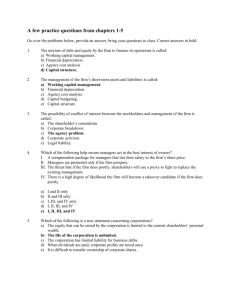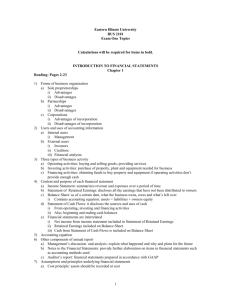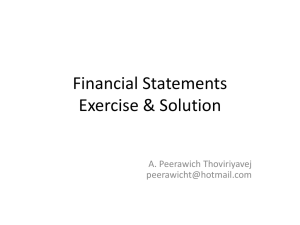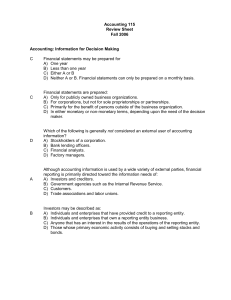TB_ch01-Introduction
advertisement
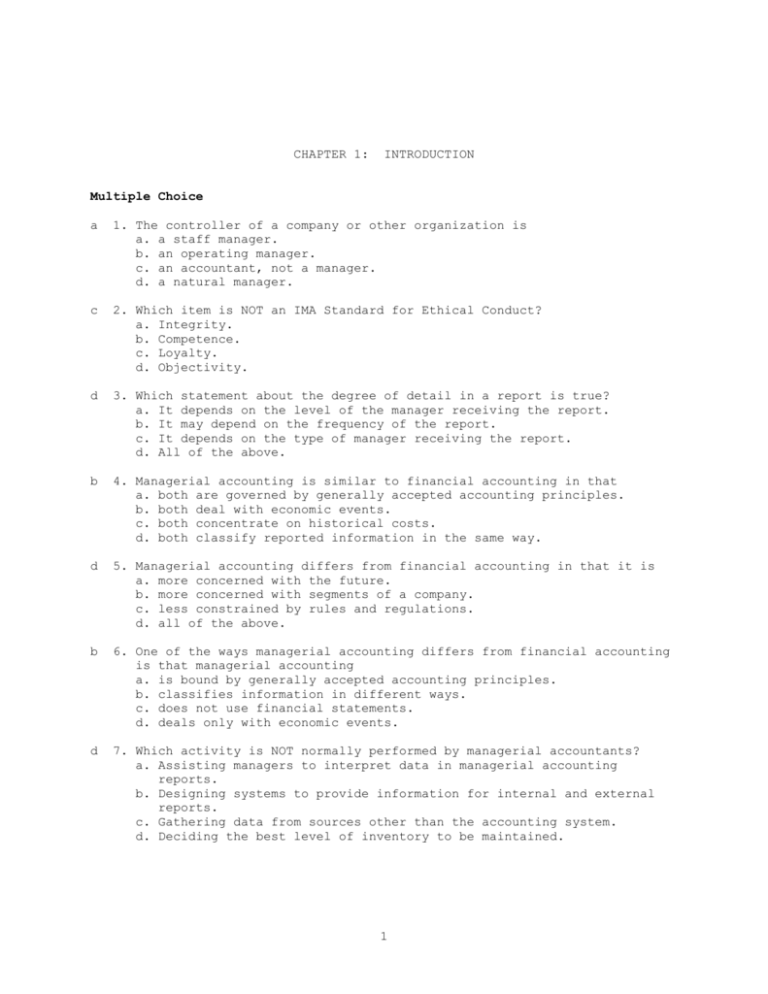
CHAPTER 1: INTRODUCTION Multiple Choice a 1. The controller of a company or other organization is a. a staff manager. b. an operating manager. c. an accountant, not a manager. d. a natural manager. c 2. Which item is NOT an IMA Standard for Ethical Conduct? a. Integrity. b. Competence. c. Loyalty. d. Objectivity. d 3. Which statement about the degree of detail in a report is true? a. It depends on the level of the manager receiving the report. b. It may depend on the frequency of the report. c. It depends on the type of manager receiving the report. d. All of the above. b 4. Managerial accounting is similar to financial accounting in that a. both are governed by generally accepted accounting principles. b. both deal with economic events. c. both concentrate on historical costs. d. both classify reported information in the same way. d 5. Managerial accounting differs from financial accounting in that it is a. more concerned with the future. b. more concerned with segments of a company. c. less constrained by rules and regulations. d. all of the above. b 6. One of the ways managerial accounting differs from financial accounting is that managerial accounting a. is bound by generally accepted accounting principles. b. classifies information in different ways. c. does not use financial statements. d. deals only with economic events. d 7. Which activity is NOT normally performed by managerial accountants? a. Assisting managers to interpret data in managerial accounting reports. b. Designing systems to provide information for internal and external reports. c. Gathering data from sources other than the accounting system. d. Deciding the best level of inventory to be maintained. 1 c 8. Conventional and just-in-time manufacturers both a. Maintain large inventories of their products. b. Sell only to other manufacturing companies. c. Desire to meet customers' deadlines. d. Require about the same amount of space to operate. d 9. Classifying costs by behavior is a. associated primarily with financial accounting. b. not relevant to a company that has only selling expenses. c. common in reports prepared for external readers. d. none of the above. a 10. Which a. By b. By c. By d. By is NOT a common accounting classification of costs? the method of payment for the expenditure. the objective of expenditure. behavior. the function incurring the expenditure. a 11. Which classification of costs is most relevant for income statements to be used internally? a. Behavior. b. Function. c. Method of payment. d. Object. d 12. The set of processes that transform raw materials into finished products is known as a a. differentiation strategy. b. flexible manufacturing system. c. lowest cost strategy. d. value chain. a 13. Income statements classifying costs by object show such items as a. tax expense, wages expense, depreciation expense. b. cost of goods sold, selling expenses, administrative expenses. c. assets, liabilities, owners' equity. d. all of the above. a 14. The period that begins with the arrival of materials and ends with the shipment of a completed good is the a. cycle time. b. manufacturing cell. c. computer-integrated manufacturing. d. performance period. a 15. Which function is most directly related to management by objectives? a. Planning. b. Control. c. Decision making. d. Reporting. d 16. Which consideration influences the frequency of an internal report? a. The wishes of the managers receiving the report. b. The frequency with which decisions are made that require the information in the report. c. The cost of preparing the report. d. All of the above. 2 a 17. A just-in-time manufacturer is more likely than a conventional manufacturer to a. receive more frequent deliveries of materials. b. spend less money on advertising. c. need workers with fewer skills. d. all of the above. c 18. A conventional manufacturer is more likely than a just-in-time manufacturer to a. have a short production cycle. b. produce goods in small batches. c. hold large inventories to serve as buffers. d. none of the above. a 19. The professional certification most relevant for managerial accountants is the a. CMA. b. CPA. c. CSA. d. MAS. d 20. A firm that is competing using a _______________________ strategy is attempting to create a perception of uniqueness that will permit a higher selling price. a. value chain b. lowest cost c. lead time d. differentiation b 21. Planning and control are a. different names for the same thing. b. the basic functions of management. c. described equally well by the terms "decision making" and "performance evaluation." d. exemplified by, respectively, financial statements and budgeting. a 22. In a. b. c. d. contrast to a balance sheet, an income statement is for a period of time, a balance sheet is at a point in time. gives information about cash and a balance sheet does not. is prepared after the statement of retained earnings. has two columns, while a balance sheet has more than two. c 23. One characteristic of the conventional manufacturing environment is a. flexible manufacturing systems. b. manufacturing cells. c. a just-in-case philosophy. d. a high degree of quality control. d 24. A characteristic of the just-in-time manufacturing environment is a. frequent deliveries of materials. b. manufacturing cells. c. little or no inventory of finished product. d. all of the above. 3 d 25. Conventional and just-in-time manufacturers differ in that the conventional manufacturer is likely to a. be a new entrant into its industry. b. need less storage space than its JIT competitors. c. give less credibility to management accounting reports. d. have a longer production cycle than its JIT competitors. True-False F 1. Published financial statements show costs classified by behavior. T 2. Generally accepted accounting principles govern financial accounting but not managerial accounting. T 3. Economic events are the raw data for both financial and managerial accounting. F 4. Internal financial statements must be prepared using generally accepted accounting principles. T 5. The form and content of reports can influence decisions made by managers. F 6. Management-by-objectives and management-by-exception are two names for the same general management principle. F 7. "Pro forma" is the name given to an income statement that classifies costs by function. T 8. Some managerial accounting reports contain costs not incorporated in the basic accounting system. F 9. A professional examination exists to test the competence of financial accountants, but not of managerial accountants. F 10. Managerial accountants should, but have no obligation to, maintain their professional skills. Problems 1. Based on the following, compute total owners' equity. Cash $ 8,000 Total assets $64,000 Total contributed capital $12,000 Total noncurrent liabilities Retained earnings $ 0 $16,000 Current liabilities $36,000 SOLUTION: $28,000 ($16,000 RE + $12,000 contributed capital) 4 2. Based on the following, compute total noncurrent assets. Total current assets Total current liabilities Retained earnings Total noncurrent liabilities Total contributed capital $600,000 $240,000 $162,000 $710,000 $360,000 SOLUTION: $872,000 ($240,000 + $710,000 + $360,000 + $162,000 - $600,000) 3. Based on the information provided, compute accrued wages payable at the end of 20X4. Accrued wages payable, beginning of 20X4 Wages expense for 20X4 Cash paid in 20X4 for wages $ 14,000 $ 45,000 $ 42,500 SOLUTION: 16,500 ($14,000 + $45,000 - $42,500) 4. Using the following data, find the missing items. Total assets, beginning of year . . . . . . . Total assets, end of year . . . . . . . . . . Total liabilities, beginning of year . . . . Total owners' equity, end of year . . . . . . Net income for year . . . . . . . . . . . . Additional investment during year . . . . . . Contributed capital, beginning of the year . $160 $240 $120 $ 60 $ 24 $ 16 $ 30 a. Total owners' equity at the beginning of the year. b. Total liabilities at the end of the year. c. Retained earnings at the beginning of the year. d. End-of-the-year retained earnings. e. Dividends declared during the year. SOLUTION: a. Total OE, $40 ($160 - $120) b. Total liabilities, $180 ($240 - $60 ) c. Beginning RE, $10 ($40 beginning owners' equity - $30 ) d. Ending RE, $14 [$60 - ($30 + $16)] 5 e. Dividends declared, $20 ($10 of beg RE + $24 - $14 ending RE) 5. Based on the following, compute total owners' equity. Cash Total assets $ 30,000 $126,000 Total noncurrent liabilities $18,000 Retained earnings $24,000 Current liabilities $56,000 SOLUTION: $52,000 (126,000 Total assets - $56,000 current liabilities - $18,000 total noncurrent liabilities) 6. Based on the following, compute total noncurrent assets. Total current assets Total current liabilities Retained earnings Total noncurrent liabilities Total owners' equity $135,000 $ 70,000 $ 47,500 $182,500 $125,000 SOLUTION: $242,500 ($70,000 + $182,500 + $125,000 - $135,000) 7. Based on the information provided, compute accrued taxes payable at the end of 20X3. Accrued taxes, beginning of 20X3 Taxes expense for 20X3 Cash paid in 20X3 for taxes $244,000 $760,000 $750,000 SOLUTION: $254,000 ($244,000 + $760,000 - $750,000) 8. Based on the information provided, compute prepaid supplies at the end of 20X5. Prepaid supplies, beginning of 20X5 Supplies expense for 20X5 Cash paid in 20X5 for supplies SOLUTION: $16,000 ($10,000 + $216,000 - $210,000) 6 $ 10,000 $210,000 $216,000 9. Using the following data, find the missing items. Total assets, beginning of year . . . . . . . Total assets, end of year . . . . . . . . . . Total liabilities, beginning of year . . . . Total owners' equity, end of year . . . . . . Net income for year . . . . . . . . . . . . Additional capital invested during year . . . Contributed capital, beginning of the year . $1,050 $1,200 $ 630 $ 480 $ 164 $ 50 $ 200 a. Total owners' equity at the beginning of the year. b. Total liabilities at the end of the year. c. Retained earnings at the beginning of the year. d. End-of-the-year retained earnings. e. Dividends declared during the year. SOLUTION: a. Total OE, $420 ($1,050 - $630) b. Total liabilities, $720 ($1,200 - $480) c. Beginning RE, $220 ($420 beginning owners' equity - $200) d. Ending RE, $230 [$480 - ($200 + $50)] e. Dividends declared, $154 ($220 of beg RE + $164 - $230 ending RE) 10. Using the following data, find the missing items. Total liabilities, beginning of year . . . Total liabilities, end of year . . . . . . Total owners' equity, beginning of year . . Total assets, end of year . . . . . . . . . Dividends declared during the year. . . . . Additional capital invested during year . . Contributed capital, beginning of the year . . . . . . . . . . . . . . a. Total assets at the beginning of the year. b. Total owners' equity at the end of the year. c. Retained earnings at the beginning of the year. d. End-of-the-year retained earnings. e. Net income for year. SOLUTION: a. Total assets, $780 ($440 + $340) 7 $440 $490 $340 $950 $ 74 $ 90 $240 b. Total owners' equity, $460 ($950 - $490) c. Beginning RE, $100 ($340 beginning owners' equity - $240) d. Ending RE, $130 [$460 - ($240 + $90)] e. Net income, $104 ($130 of ending RE + $74 - $100 beginning RE) 8




